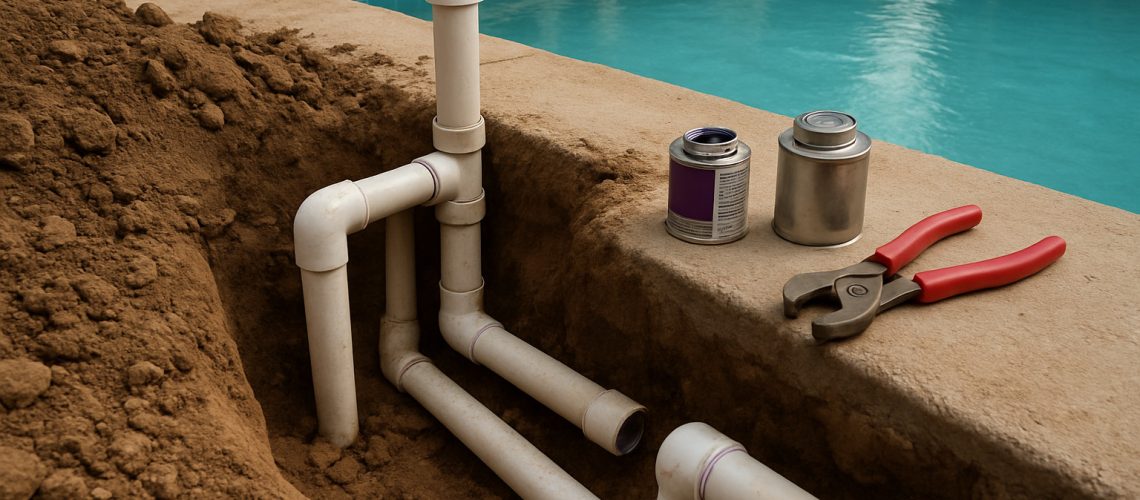The Hidden Crisis Beneath Your Pool Deck
Fixing leaks in underground pool pipes is a challenging but solvable problem for property managers dealing with water loss and structural concerns. Here is the essential information you need:
| Quick Guide: Fixing Underground Pool Pipe Leaks |
|---|
| 1. Common Causes: Soil shifting, pressure cycles, failed glue joints, tree roots |
| 2. Detection Methods: Pressure testing, acoustic listening, dye testing |
| 3. Traditional Repair: Excavation, cutting concrete, pipe replacement (costly, disruptive) |
| 4. Modern Solution: No-dig polyvinyl injection technology (faster, non-disruptive) |
| 5. When to Call Professionals: Water loss exceeding 1 inch per week, air in return lines, damp spots around pool |
Your beautiful South Florida pool is the crown jewel of your property – until it is not. When underground pipes begin to leak, what starts as a minor water loss can quickly escalate into structural damage, tenant complaints, and skyrocketing water bills.
“You do not have to deal with leaking pipes in your swimming pool!” This simple statement carries real weight for property managers overseeing high-value residential or commercial buildings. Underground pool plumbing leaks are not just inconvenient – they can be devastating to a property’s infrastructure and operating budget.
Underground pool pipes usually fail at connection points where glue joints deteriorate or threaded fittings loosen over time. In South Florida’s environment, the combination of high water tables, shifting soils, and concrete’s naturally porous nature creates the perfect storm for water infiltration problems.
Traditional repair often means destructive excavation – jackhammering through a pristine pool deck and disrupting tenant access for days. CL Wizard’s high-precision injection method changes that narrative by eliminating demolition, permits, and long shutdowns.
For large-scale properties, contact CL Wizard through the website form so the team can assess any leaks and provide a quote that outperforms traditional concrete repair – all without disrupting daily life or business.

Explore more about fixing leaks in underground pool pipes:
Understanding Why Underground Pool Pipes Leak
Ever wonder why those underground pool pipes just will not stay leak-free? In South Florida’s unique environment, your pool’s plumbing system faces a perfect storm of challenges that can lead to frustrating and costly leaks.
Soil shifting is a major culprit in our sandy terrain. When heavy rains saturate the ground or drought conditions cause soil to contract, rigid PVC pipes undergo stress at their connection points. Think of it like repeatedly bending a plastic straw – eventually, tiny cracks appear and water escapes.
Pressure cycles put your pipes through a daily workout. Each time your pool pump turns on and off, the plumbing experiences pressure swings. For commercial properties with powerful pumps, these swings are even more dramatic.
“A pool’s plumbing system experiences thousands of pressure cycles each year,” explains Marco Aurelio, founder of CL Wizard. “Each cycle creates microscopic stress on connection points – it is not a question of if they will fail, but when.”
Glue joints are particularly vulnerable. Solvent cement that seemed secure during installation gradually breaks down, especially in areas with high water tables. Many properties built decades ago used adhesives that simply were not designed to withstand today’s intensive chemical treatments.
Tree roots are silent invaders with noisy consequences. South Florida’s vegetation sends roots searching for water, and they can crush or penetrate pipes completely.
Even here, subtle temperature changes cause pipes to expand and contract. This movement, combined with constant vibration from pool equipment, acts like a slow-motion earthquake on plumbing connections.
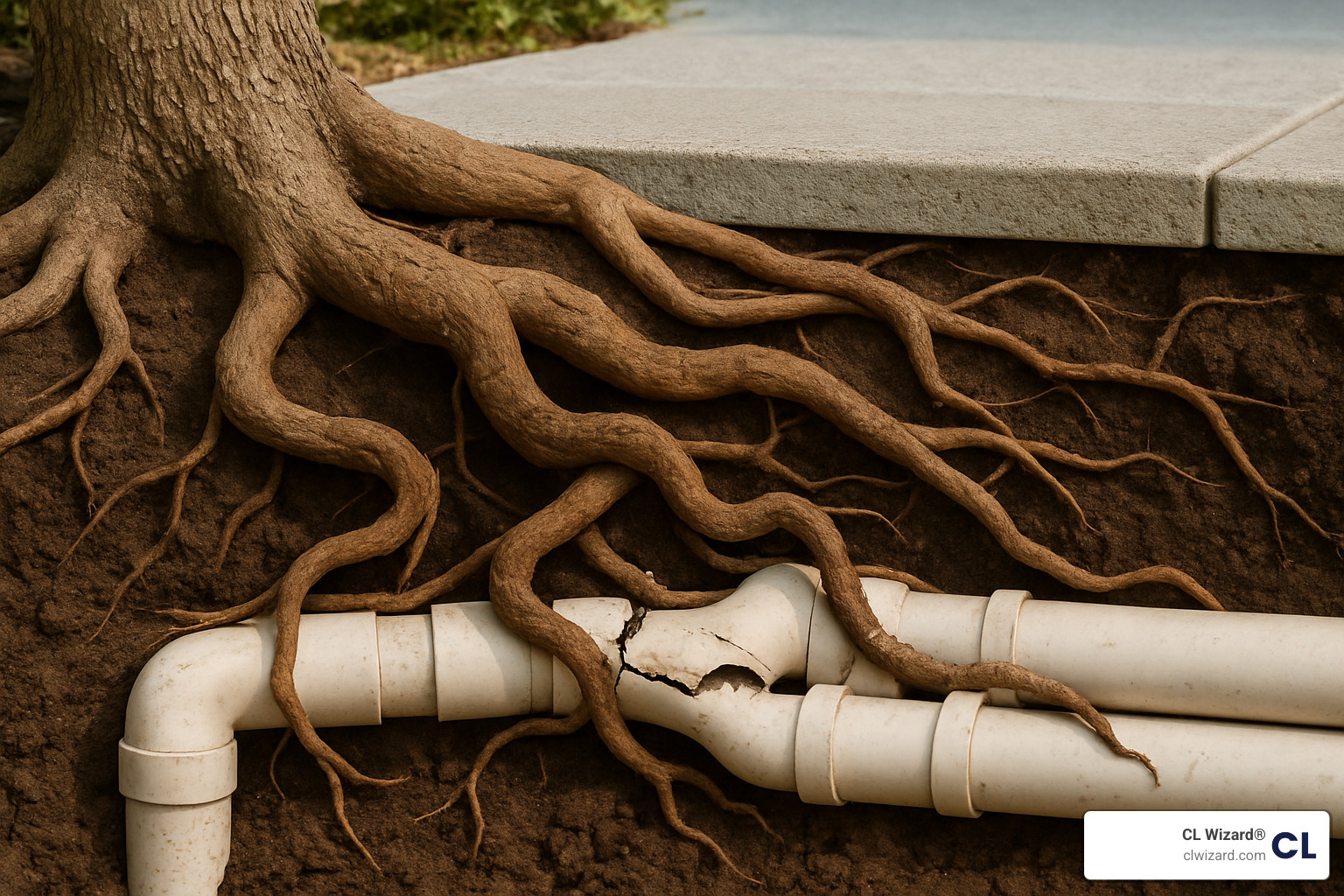
Concrete’s Hidden Weakness
Concrete seems solid, but it contains thousands of microscopic capillary voids – tiny channels that let water migrate.
“Concrete is not a waterproof barrier – it is more like a very slow sponge,” notes Marco Aurelio. “Water from leaking pipes will travel through micro-cracks and capillaries, potentially causing far-reaching damage.”
This means you are losing pool water and undermining structural concrete at the same time. Repeated exposure can lead to hydrophilic expansion, where concrete actually swells and develops new pathways for water.
High chlorine levels only accelerate this deterioration. CL Wizard’s injection system addresses both the leak and the migration path, curing into a flexible barrier that moves with your structure rather than against it.
Detecting Subsurface Plumbing Failures
Before fixing leaks in underground pool pipes, you need to know exactly where those leaks are hiding. For commercial properties, early detection saves you from small issues becoming massive headaches.
The simplest place to start is the bucket test. Fill a bucket with pool water, set it on a step, mark the water levels inside and outside, and check back a day later. If your pool level drops more than the water in the bucket, you have a leak.
“While the bucket test confirms water loss, it is like knowing you have a hole in your pocket without knowing where,” says Marco Aurelio. “Commercial properties need more sophisticated detection to pinpoint underground failures.”
Professional leak detection begins with pressure testing. By isolating sections of plumbing and applying controlled pressure, experts identify which line is compromised. If a section cannot hold pressure, that line has a leak.
Acoustic listening devices pick up the distinctive sound of water escaping pressurized pipes, even through thick concrete decks. Thermal imaging cameras reveal temperature differences created by leaking water.
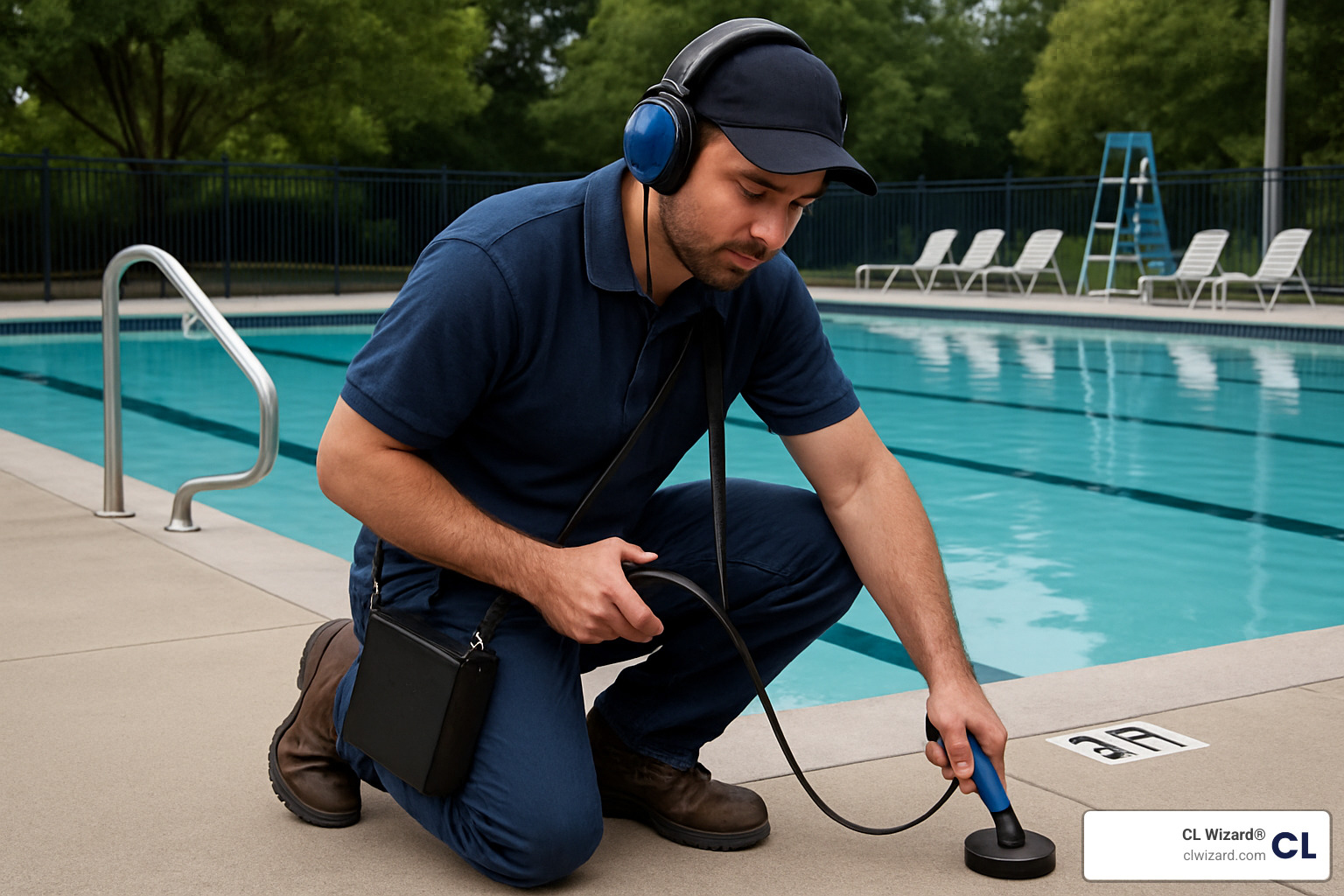
For visible confirmation, dye testing is effective around skimmers and main drains. Add food-grade dye near a suspected area while the pump is off; if the dye is pulled into a crack or fitting, you have found your suction-side leak.
Electronic locators map the underground route of pipes, crucial for older properties that lack accurate plans.
Obvious symptoms include damp soil around the pool and return jets that sputter air – clear signs of a suction-side leak drawing air into the system.
You can learn more about these detection methods on our water leak detector for pools page.
Professional Leak-Tracking Tools
Commercial jobs require commercial-grade tools. Digital pressure rigs measure tiny pressure losses, hydrophones isolate leak sounds, and endoscope cameras provide visual confirmation inside pipes.
“When managing commercial pool systems, guesswork is not acceptable,” says Marco Aurelio. “Our advanced detection tools locate underground leaks with surgical precision, minimizing disruption during repair.”
Signs You Need Professional Repair
Certain symptoms demand immediate attention:
- Rapid water loss exceeding one inch per week.
- Pump cavitation from air entering suction lines.
- Soil washouts creating voids under the deck.
- Deck settling or cracking indicating undermined concrete.
The good news? With proper detection and CL Wizard’s non-invasive solution, even serious leaks can be fixed without major disruption.
Traditional Repairs vs. High-Precision Injection Solutions
Property managers choosing how to fix leaks in underground pool pipes face a critical decision that impacts budget, timeline, and guest experience.
Traditional cut-and-replace approaches involve excavating around the leak, jackhammering through the deck, replacing pipe sections, and rebuilding everything removed. Permits, multiple contractors, noise, dust, and long closures follow.
“Traditional methods often turn a simple leak into a major construction project,” says Marco Aurelio. “For commercial properties, that downtime is rarely acceptable.”
CL Wizard’s proprietary injection method offers a smarter alternative. No digging, no demolition, zero permits, and same-day reopening in most cases. A specialized polyvinyl liquid flows like water to reach every crevice, then cures into a rubber-like seal that permanently fixes the leak.
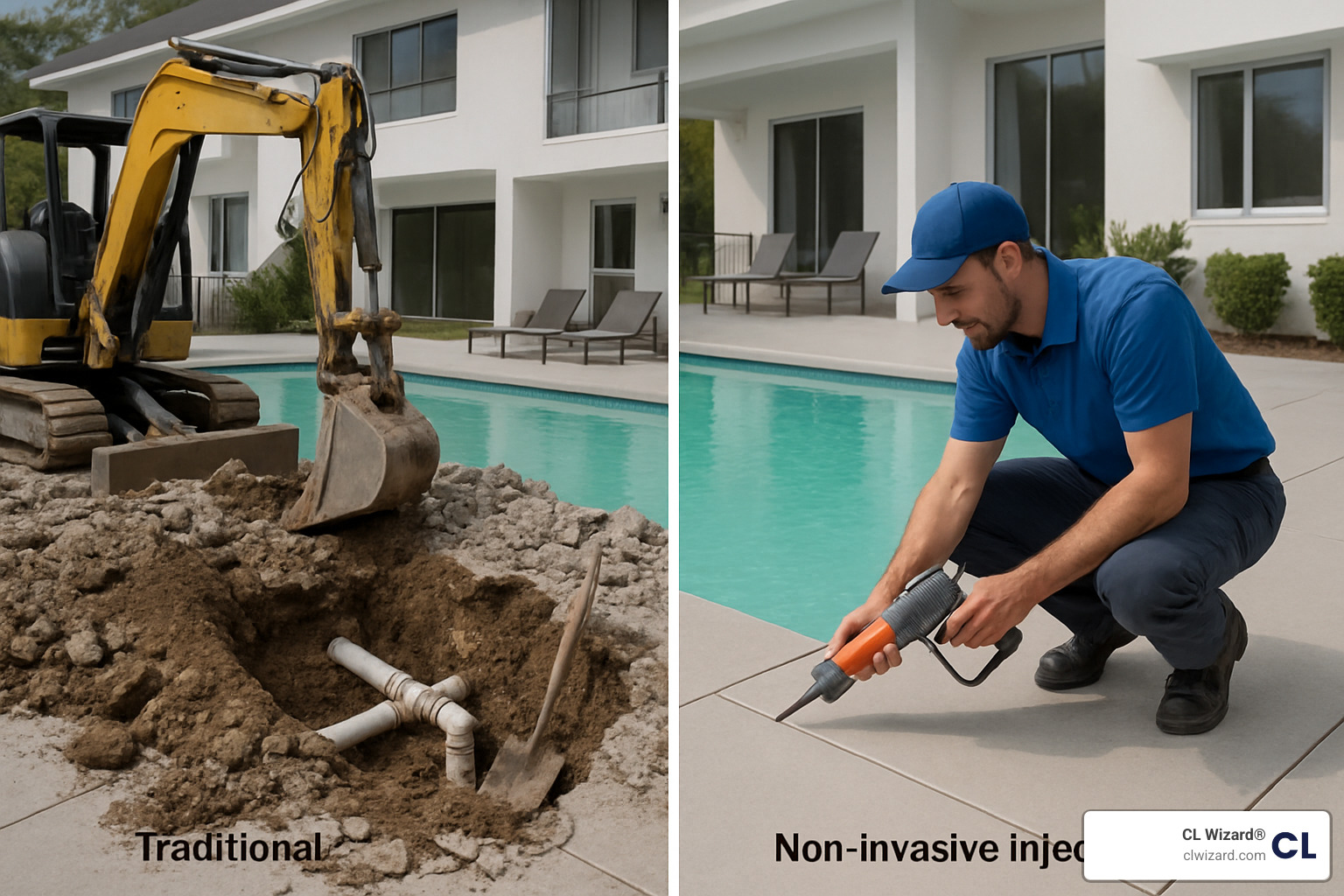
| Comparison | Traditional Excavation | CL Wizard Injection |
|---|---|---|
| Disruption | Major: digging, noise | Minimal: no digging |
| Timeline | Days to weeks | Same day |
| Permits | Required | None |
| Cosmetic Damage | High restoration | None |
| Guest Impact | Pool closure, dust | Minimal |
| Long-Term Result | Depends on workmanship | Permanent flexible seal |
| Total Cost | High after restoration | Lower overall |
For high-rise condos, resorts, and commercial pools, the choice is clear. CL Wizard delivers permanent results without sacrificing property aesthetics or guest satisfaction.
Fixing Leaks in Underground Pool Pipes: The Professional Process
CL Wizard’s proprietary injection method follows a precise, no-dig workflow that delivers permanent results without chaos.
The process starts with a pressurize-isolate phase. Controlled pressure testing pinpoints exactly where water is escaping and maps the leak pathway.
Once located, technicians perform thorough internal cleaning to remove mineral deposits and biofilm, ensuring perfect adhesion of the repair material.
Next comes the multi-stage injection. The polyvinyl liquid flows like water, following the exact path of the leak, then cures into a rubber-like material that flexes with normal pipe movement.
Finally, camera verification confirms the seal, and most pools reopen the same day.
Step-by-Step Summary
- Comprehensive leak mapping with acoustic and pressure tools.
- Line flushing and preparation.
- Controlled pressure injection of the polyvinyl solution.
- Curing period and camera verification.
- Same-day reopening.
Safety, Speed, and Longevity
No demolition means no trip hazards, dust, or damage to surrounding structures. Minimal noise keeps guests happy. The flexible seal has a 25-year design life, and because no permits are required, repairs move forward faster and at lower cost.
Prevention & Proactive Maintenance
While fixing leaks in underground pool pipes is essential when problems arise, preventive maintenance protects your investment.
Balanced pool chemistry is the first line of defense. Water with low pH or aggressive chemical levels silently attacks metal and plastic plumbing.
Installing permanent pressure gauges on key lines provides an early warning. Gradual pressure drops often indicate a developing leak long before it is visible.
Schedule seasonal inspections – ideally before and after the rainy season – when shifting ground conditions place extra stress on underground piping.
Proper pipe support and surge protection devices help absorb pressure spikes and minimize joint stress.
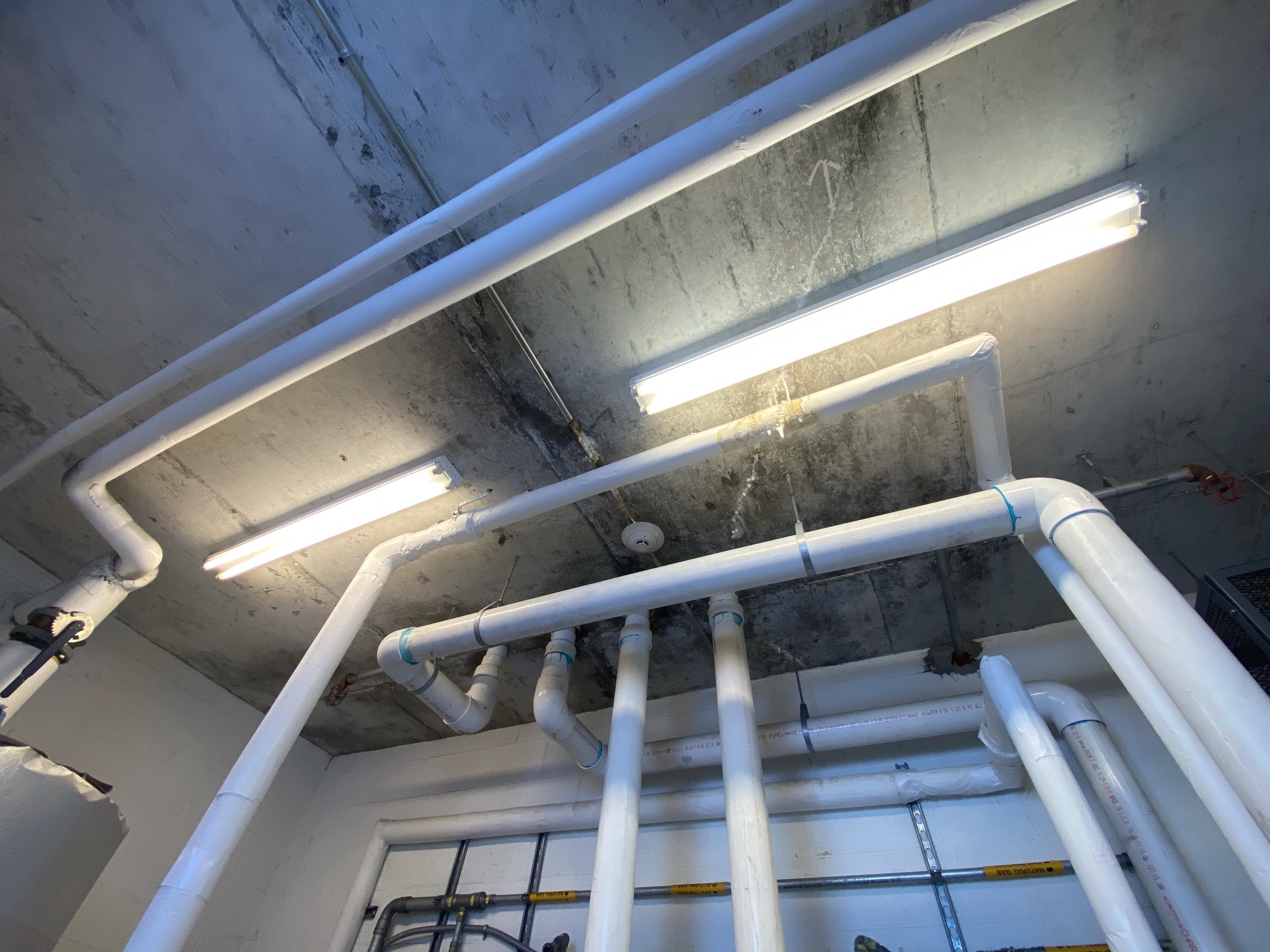
Learn more about comprehensive preventive care on our swimming pool leak specialists page.
After-Repair Care
After CL Wizard repairs a leak, systematic data logging of water levels, chemical readings, and pressure measurements establishes a performance baseline. Annual professional audits, pressure testing, and routine debris control keep your system in top shape.
“Data is your best ally in preventing future leaks,” says Marco Aurelio. “Regular monitoring lets you catch issues early and avoid disruption.”
Frequently Asked Questions about Fixing Leaks in Underground Pool Pipes
What makes injection repair last longer than patching?
Traditional patches only cover the surface of a problem. CL Wizard’s polyvinyl injection fills every microscopic channel where water travels, then cures into a flexible seal that moves with the pipe instead of cracking.
How soon can the pool reopen after the repair?
In most cases, commercial pools reopen the same day – sometimes within hours of final inspection – because the solution cures quickly and no demolition debris needs removal.
Is any digging ever unavoidable?
In the rare event of a completely collapsed or crushed pipe, limited excavation may be necessary to restore flow before injection. Even then, CL Wizard minimizes digging compared with traditional methods, protecting your deck and shortening downtime.
Conclusion
Fixing leaks in underground pool pipes no longer requires tearing up your deck or closing your property for weeks. CL Wizard’s polyvinyl injection technology delivers a permanent, permit-free, no-dig solution that keeps South Florida pools open and guests happy.
By following water’s path and sealing every void, CL Wizard prevents future infiltration, speeds up repairs, and slashes total costs compared with traditional cut-and-replace methods.
Follow us!

